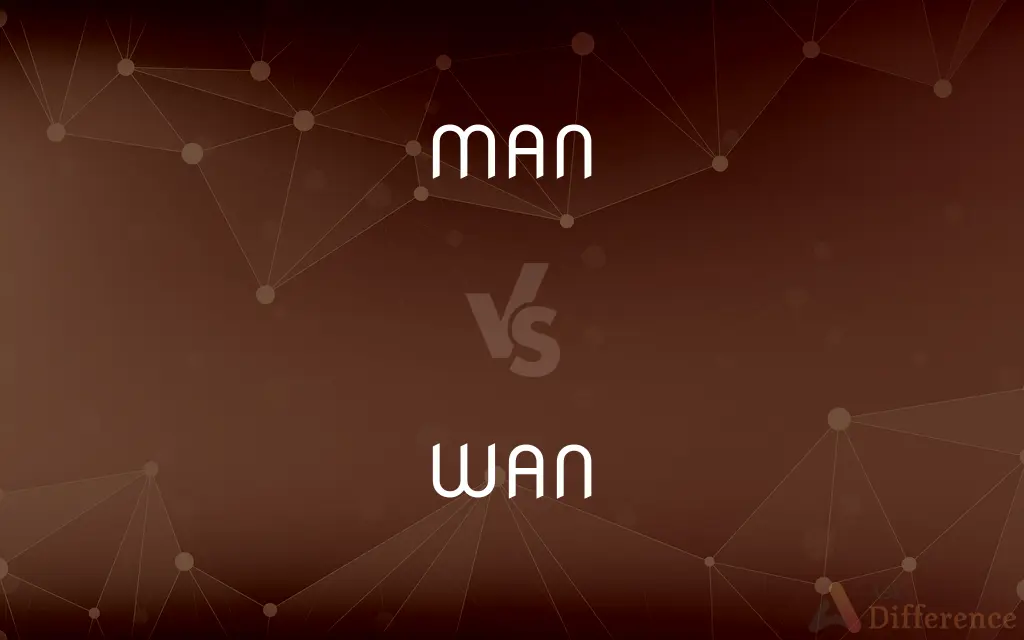MAN vs. WAN — What's the Difference?
By Tayyaba Rehman & Urooj Arif — Published on January 31, 2024
MAN (Metropolitan Area Network) covers a city-sized area, while WAN (Wide Area Network) spans a much larger geographical area, often across countries or continents.

Difference Between MAN and WAN
Table of Contents
ADVERTISEMENT
Key Differences
A MAN (Metropolitan Area Network) is designed to cover a larger geographic area than a LAN (Local Area Network) but is confined to a specific metropolitan area, such as a city or a large campus. This makes it ideal for connecting multiple buildings within this area. A WAN (Wide Area Network), in contrast, covers a much larger geographic scope, often connecting different cities, countries, or even continents, facilitating long-distance communication and data sharing.
The infrastructure of a MAN typically involves high-capacity and high-speed fiber optic cables to handle the large volume of data traffic within a metropolitan area. It is often used by government agencies, large corporations, or educational institutions to connect various local networks within the city. On the other hand, a WAN relies on a complex mix of public and private networks, including leased lines, satellites, and VPNs (Virtual Private Networks) over the public Internet, to establish long-distance and global connectivity.
MANs are often managed by a single organization or a group of entities that collaborate for local connectivity. This makes management and maintenance more centralized compared to WANs. WANs involve multiple telecommunications providers and are typically decentralized in their management, as they encompass different regions, countries, and networks, each with its own policies and management.
In terms of speed and latency, a MAN typically offers higher speeds and lower latency due to its limited scope and the use of advanced infrastructure within a smaller area. A WAN, given its extensive range, usually experiences higher latency and lower speeds, as data has to travel over longer distances and through various network segments.
The use-case scenarios for a MAN include connecting city government buildings, linking campuses of a university, or integrating the networks of a corporation with multiple local offices. In contrast, a WAN is used for connecting offices in different cities or countries, enabling global data sharing, and supporting remote workforces across large distances.
ADVERTISEMENT
Comparison Chart
Geographic Scope
City or metropolitan area.
Multiple cities, countries, or continents.
Infrastructure
High-speed fiber optics.
Mix of public/private networks, satellites.
Management
Often centralized.
Decentralized, involving many providers.
Speed and Latency
Higher speeds, lower latency.
Lower speeds, higher latency.
Use Cases
Connecting buildings in a city.
Global connectivity, remote offices.
Compare with Definitions
MAN
It is larger than a LAN but smaller than a WAN.
The company used a MAN to connect its downtown office with the suburban branches.
WAN
WAN spans large geographical areas, often across countries.
The corporation's WAN connected its offices from New York to Tokyo.
MAN
MAN connects local networks within a specific metropolitan area.
The city's MAN seamlessly linked all the public libraries and schools.
WAN
It integrates multiple smaller networks over long distances.
Through the WAN, employees could access the company's database from anywhere in the world.
MAN
MANs are often operated by single entities or consortia.
The local government and businesses collaborated to establish a MAN in the city.
WAN
WANs face challenges like higher latency and varying regulations.
Despite the latency, the WAN was crucial for the company's global operations.
MAN
MAN often uses high-capacity fiber optic cables.
The university's MAN facilitated high-speed internet across the entire campus.
WAN
WANs use a mix of leased lines, satellites, and VPNs.
The company utilized VPNs to secure its WAN communications.
MAN
It is ideal for city-wide connectivity.
The metropolitan area network made sharing resources between city departments efficient.
WAN
Ideal for global communication and data sharing.
The international research project relied on a WAN to collaborate across continents.
WAN
A communications network that uses such devices as telephone lines, satellite dishes, or radio waves to span a larger geographic area than can be covered by a LAN.
Common Curiosities
Can a MAN connect to a WAN?
Yes, a MAN can be part of a larger WAN.
How large is a WAN?
It can span across countries or continents.
Who typically uses a MAN?
Governments, universities, and large corporations within a city.
What does MAN stand for?
Metropolitan Area Network.
Is a WAN faster than a MAN?
Generally, a MAN is faster due to shorter distances.
What infrastructure does a MAN use?
Mainly high-capacity fiber optic cables.
Do WANs require special technologies?
They often use technologies like satellite links and leased lines.
How is a MAN managed?
It's often centrally managed by one organization or a consortium.
Can I access a WAN from home?
Yes, if you have a connection to the WAN, such as through a VPN.
Why use a WAN?
For global connectivity and long-distance communication.
Are WANs secure?
WANs can be secure, often using VPNs and encryption.
Can a MAN cover an entire city?
Yes, that’s its primary purpose.
Are MANs and WANs mutually exclusive?
No, they can be interconnected as part of a larger network infrastructure.
What is a common use of a MAN?
Connecting local government buildings or educational campuses.
How does latency compare between MAN and WAN?
MAN typically has lower latency than WAN.
Share Your Discovery

Previous Comparison
Informed Search vs. Uninformed Search
Next Comparison
Server-Side Scripting vs. Client-Side ScriptingAuthor Spotlight
Written by
Tayyaba RehmanTayyaba Rehman is a distinguished writer, currently serving as a primary contributor to askdifference.com. As a researcher in semantics and etymology, Tayyaba's passion for the complexity of languages and their distinctions has found a perfect home on the platform. Tayyaba delves into the intricacies of language, distinguishing between commonly confused words and phrases, thereby providing clarity for readers worldwide.
Co-written by
Urooj ArifUrooj is a skilled content writer at Ask Difference, known for her exceptional ability to simplify complex topics into engaging and informative content. With a passion for research and a flair for clear, concise writing, she consistently delivers articles that resonate with our diverse audience.
















































